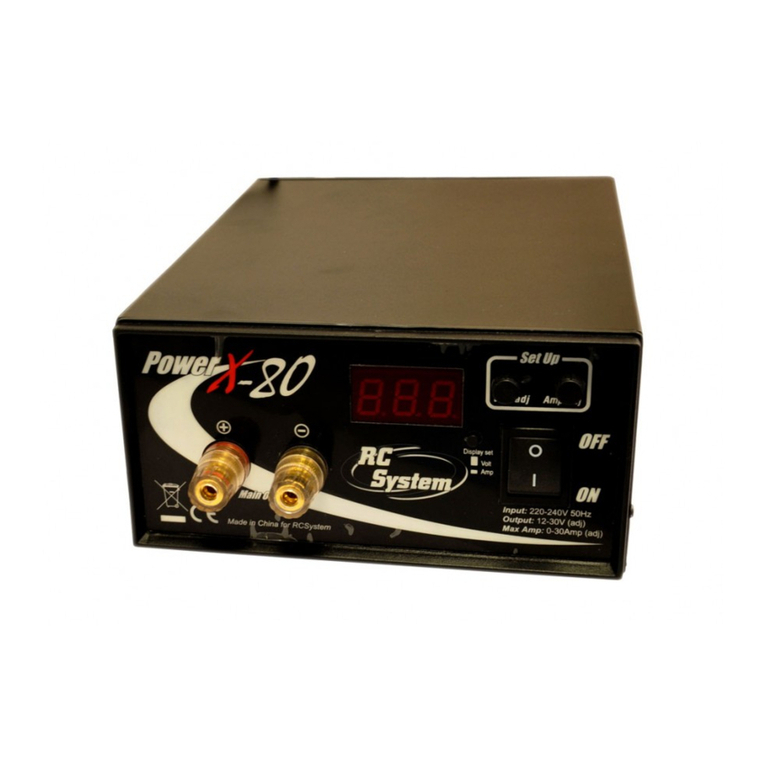SA10126 RC SYSTEM BILANCIATORE LiPo
Guida dell’utente
La tecnologia di bilanciamento avanzata dell’SA10126 fornisce un bilanciamento attivo e un caricamento sicuro per le vostre batterie LiPo, è
importante che leggiate il manuale e usiate il bilanciatore correttamente. Usate questo bilanciatore SOLO per pacchetti da 2 a 5 celle.
Caratteristiche Principali:
1. Rileva automaticamente le celle per ogni tipo di pacchetto da 2 a 5 celle.
2. Bilancia automaticamente e celle da 2 a 5 celle in serie prima o dopo il caricamento.
3. Rileva automaticamente le celle difettose prima del caricamento, il LED rosso lampeggerà velocemente quando il voltaggio delle celle è
superiore a 4,35V o inferiore a 3,0V.
4. Bilancia automaticamente lo sbilanciamento delle celle durante la carica, passerà una corrente di by-pass e il relativo LED verde lampeggerà.
5. Il bilanciatore automaticamente taglierà il caricamento quando ognuna delle celle raggiungerà 4,3V o tutto il voltaggio delle celle sarà di 4,25V.
Specifiche:
Range di voltaggio in entrata: da 6 a 22,5V Massima corrente di by-pass: 400mA
Protezione da basso voltaggio: 3,0V +/- 0,01V Auto bilanciamento entro: +/- 0,01V
Massima corrente di carica: 6° Protezione da sovra voltaggio: 4,3V +/- 0,01V
Voltaggio di controllo sbilanciamento: +/- 0,01V
Funzionamento dei LED
SA10126 ha 1 LED rosso e 5 LED verdi. Segue il loro funzionamento dettagliato:
●funzionamento LED Rosso (LED di status)
1. indicazione di difetto: prima di caricare, il bilanciatore rileverà automaticamente le celle, il LED rosso lampeggerà velocemente per 15
secondi e si spegnerà quando il voltaggio di ogni cella sarà più alto di 4,35V o più basso 3,0V; dopo la carica, il bilanciatore automaticamente
rileverà di nuovo le celle, il LED rosso lampeggerà velocemente per 15 secondi e si spegnerà quando il voltaggio di ogni cella sarà più basso
di 3,7V. Si prega di notare che quando il LED rosso lampeggia velocemente il bilanciatore taglierà automaticamente il circuito di carica e il
circuito di bilanciamento per sicurezza.
2. indicazione di circuito di bilanciamento in situazione normale: dopo aver rilevato le celle, il LED rosso si accende e significa che il circuito di
bilanciamento si trova in situazione normale e è pronto per iniziare il caricamento.
3. indicazione di carica: il LED rosso sarà acceso quando il bilanciatore si troverà in situazione di carica normale
4. indicazione di taglio del caricamento: durante la carica, quando il voltaggio di una delle celle è più alto di 4,3V o quando tutte le celle
raggiungono i 4,25V, il LED rosso lampeggerà lentamente per 15 secondi e poi taglierà e, nel preciso istante, il bilanciatore taglierà il circuito
di bilanciamento e quello di carica per sicurezza (nel caso in cui il caricatore sbagli il taglio della carica).
●funzionamento dei LED verdi
1.Cell indication: The balancer will detect the cell quantity before charging, the relative green LEDs will be on for about 5sec, and then turn off;
when there is no cell or the cell voltage lower than 1.5V, the relative green LEDs will turn off.
2. Cell defective indication: Before charging, if there is any cell voltage higher than 4.35V or lower than 3.0V, the relative green LED will be flash
quickly for about 15sec and then turns off; after charging, if there is any cell voltage lower than 3.7V, the relative green LED will be flash
quickly for about 15sec and then turns off. (Please notice that whenever the green LED flash quickly, the balancer will automatically cut-off the
charging circuit and the balancing circuit for safety purpose)
3. Balancing indication: When there is any cell imbalance, the relative green LED will flash slowly, the by-pass function is on.
Procedura di funzionamento e gestione di malfunzionamento
Passo 1: rilevamento automatico delle celle prima del caricamento
1.1 connettere il connettore del bilanciatore della batteria al bilanciatore, il bilanciatore comincia a rilevare le celle e i LED mostreranno lo status.
1.2 Se il LED rosso e/o quelli verdi non lampeggiano velocemente e i LED verdi mostrano la stessa quantità di celle della batteria, e
successivamente il LED rosso s’accenda, potrete procedere al passo 2.
1.3 Se il LED rosso e/o quelli verdi lampeggiano velocemente significa che il voltaggio della relativa cella è superiore a 4,35V o inferiore a 3,0V,
scollegate la batteria, avrete bisogno di un ausilio professionale o di disporre correttamente la batteria.
1.4 Se trovaste che la quantità di celle non è la stessa mostrata dal bilanciatore, o che il relativo LED verde non s’accende o non lampeggia,
controllare se il collegamento tra la batteria e il bilanciatore sia corretto, e ricollegate nuovamente. Se il problema dovesse persistere dopo il
ri-collegamento avrete bisogno di un ausilio professionale.
Passo 2: collegare il caricatore e procedere con la carica
2.1 inserire il connettore della batteria all’uscita del bilanciatore, collegare l’entrata del bilanciatore all’uscita del caricatore. Impostare il caricatore
seguendo le istruzioni e le specifiche delle batterie, e avviare la carica. Si prega di controllare il processo di carica e assicurarsi che sia in
buone condizioni. Normalmente il LED rosso del bilanciatore sarà acceso.


























